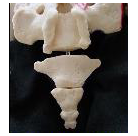- Coccygectomy is the surgical amputation, or removal, of the coccyx (removal of the tailbone).
- After a coccygectomy, it is relatively common to develop a fluid collection at the surgical site.
- I spoke with a group of European coccygectomy surgeons about this topic when I lectured at the International Coccyx Pain Symposium in 2016 and again in 2018. None of the surgeons were entirely sure of exactly why the fluid collection happens, or how best to treat it.
- The best we can explain it is that after the coccyx is removed there is some space present where the tailbone used to be, and inflammation/fluid after the surgery sort of fills that area. I compare this to removing a few shovels full of dirt from the ground in your backyard, and before long it will fill with water and you will have a puddle.
- After a coccygectomy, the fluid would mainly be seen on imaging studies such as MRI.
- On MRI, the doctors can carefully look to see if the fluid contains any retained bony fragments from the coccyx, which may have been accidentally “left behind” at the time of surgery.
- Sometimes the fluid collection will persist for many months after the coccygectomy.
- In some instances the fluid may resolve over time.
- There is no officially established protocol for how to deal with the fluid or whether anything should be done with it at all.
- If the patient is having substantial symptoms, then treatment is reasonable.
- One consideration would be to put a needle into the fluid in order to send a fluid sample for testing.
- Specifically, the testing of the fluid would be to look for any infection. So the testing of the fluid could include looking for bacteria by doing a gram stain and then looking for bacteria under a microscope. Testing could also include a bacterial culture/sensitivity, where the doctors try to grow whatever miscro-organisms were found in the fluid. Testing could also include looking at the white blood cell count [WBC count] within the fluid, because infection is often associated with a high WBC count.
- Certainly if there is redness and warmth at the skin over the fluid collection, or if the patient has a fever, those things would be clinical signs concerning for infection within the underlying fluid. The higher the clinical suspicion for infection, the more likely that the doctor will want to test for infection and/or start antibiotics to treat the infection.
- A localized collection of infection like this is often referred to as an “abscess.” If it looks like there is a local infection at the site, then typically the doctor would NOT want to inject any steroid at that area, since injecting a steroid into an active infection could make the steroid worse.
- Using a needle to remove the fluid might potentially be helpful at relieving the fluid pressure/pain in the area, although it is certainly possible that some or all of the fluid might just re-accumulate.
- In rare cases, a fluid collection might be due to prolapse (sagging) of the rectum. Rectal prolapse means that the rectum has moved out of its normal position and has instead moved into a different area. (In this case, it could be that the rectum is moving into the area where the tailbone used to be.)
-
In general, make sure your physicians are assessing the skin for redness/warmth to make sure there is no sign of infection.
-
Also, ask your local physicians whether they have anyone local to you who would be able to look at this under ultrasound and see if the area where the fluid is located may match the area where you are having your symptoms. They could also consider removing the fluid by inserting a needle under ultrasound guidance.
-
Also, please make sure that your coccygectomy surgeon sees the MRI report and the CD images of the fluid, and ask for his/her thoughts and advice on this issue.
GET THE BOOK: To get your copy of the book “Tailbone Pain Relief Now!” go to: www.TailboneBook.com or go to Amazon.
COME FOR RELIEF: For more information on coccyx pain, or to be evaluated in-person at Dr. Foye’s Tailbone Pain Center in the United States, go to: www.TailboneDoctor.com
– Patrick Foye, M.D., Director of the Coccyx Pain Center, New Jersey, United States.
Latest posts by Patrick Foye, M.D. (see all)
- Coccygectomy: Expected Recovery and Return to Work after surgery for coccyx pain, tailbone pain. - November 28, 2023
- PRP Platelet Rich Plasma or Prolotherapy for Tailbone Pain, Coccyx Pain - October 25, 2023
- Reasons for Normal X-rays and MRI Despite Tailbone Pain, Coccyx Pain - October 3, 2023

